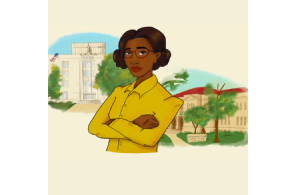In honor of Black History Month, Thompson Coburn has created an educational coloring book celebrating Gloria Bradford, the first African American woman to graduate from the University of Texas School of Law. The Firm encourages everyone to access the PDF of the coloring book, “Gloria Katrina Bradford: Images from the Life and Legacy of a Texas Legal Pioneer,” and print it out for young people to color and read a firsthand account of what it was like to be one of the first African Americans in Texas to practice law.
The idea for the seven-page coloring book came from an article written by Dallas partner Jasmine Wynton for the journal of the Texas Supreme Court Historical Society, “A Profile in Courage: Gloria Katrina Bradford.” (Jasmine serves on the board and executive committee of the Historical Society.) Since being published in the Fall 2020 issue of the journal, the article has been well-received in the Texas legal community; many attorneys were not aware of Gloria Bradford or her role as a legal pioneer.
“As a past history major and an African American woman, I find Ms. Bradford’s story fascinating and her courage remarkable,” said Jasmine. “When you take a closer look at her life and contributions, you see the perseverance and sacrifice it took to break down both racial and gender barriers and clear the way for someone like me to practice law in Texas. I hope my article and this coloring book help more people to know the power of her story.”
Born in 1930 in Houston, Gloria was one of the first African American students to attend law school at the University of Texas at Austin. She enrolled in the law school in 1951, just a year after the U.S. Supreme Court’s decision in Sweatt v. Painter, which ordered UT Law School to admit qualified African American applicants. It would be another three years before the Supreme Court would decide the landmark Brown v. Board of Education case, which declared racial segregation in public schools unconstitutional.
The coloring book shares Gloria’s experiences as a student on the newly integrated UT Law School campus and the early years of her career, following her graduation in 1954. It also details several of the first cases Gloria took on as an attorney, including a discrimination case against her alma mater for refusing to admit African Americans to its undergraduate program following the Sweatt and Brown decisions. Gloria also handled an appeal for the NAACP, in which she collaborated with future Supreme Court Justice Thurgood Marshall.




